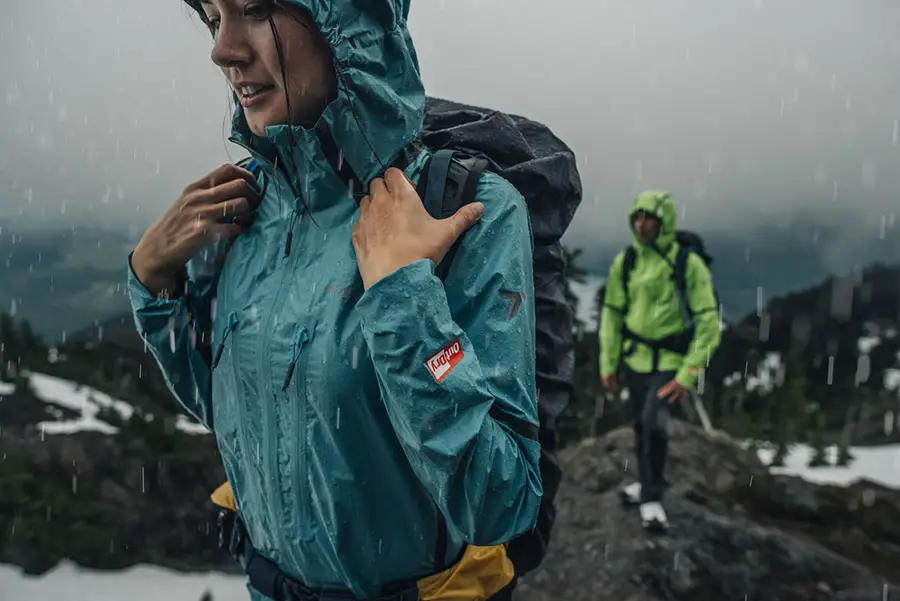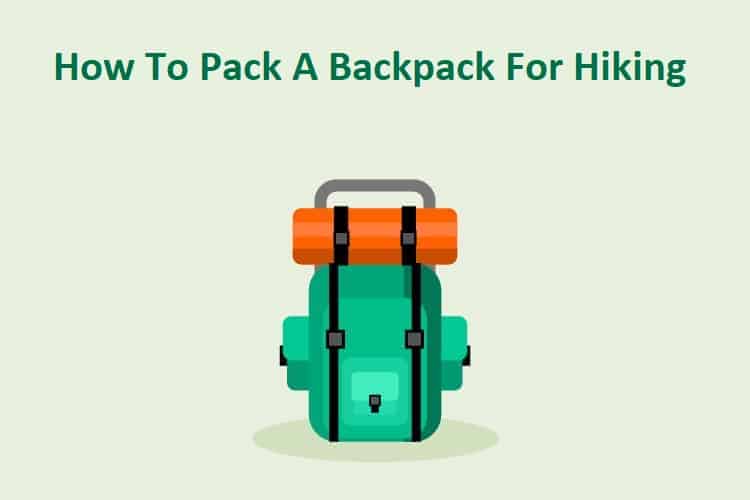Back in the day, waterproof hiking jackets were heavy, cumbersome, and sweaty affairs that made the hiker feel as though they’d been shrink-wrapped and trapped in a sauna.
Thankfully, times have changed. Circa 1969, Gore-Tex shook our worlds with the introduction of the first iteration of the waterproof-breathable membranes that are now used by just about every big-name brand out there.
Nowadays, we have an absolute wealth of high-performing waterproof jackets at our disposal, from ultralight backpacking models to “bombproof” mountaineering models.
But choosing the best jacket for your needs isn’t as simple as just plucking the most suitable-looking big-name-branded jacket from the shelves, and there’s far more nuance and subtlety that goes into the making of a good jacket than many expect.
We aim to offer an in-depth analysis of those nuances and subtleties with a view to helping you choose the best waterproof jacket for your outdoor adventures.
Knowing your needs
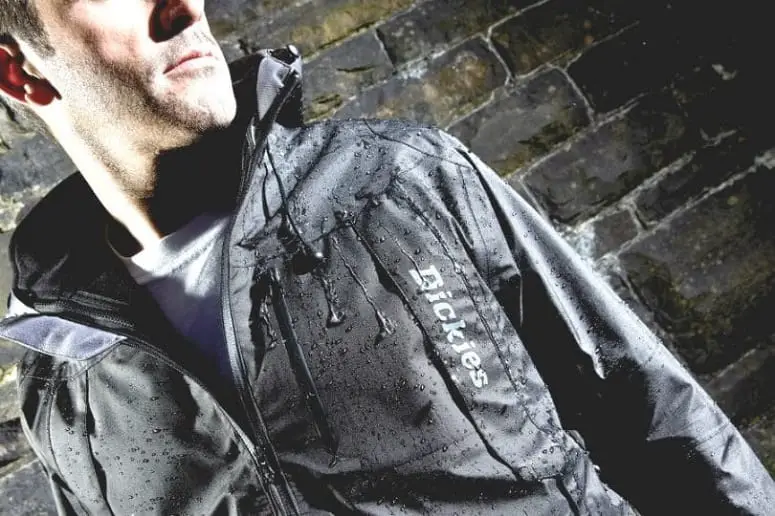
Owing to the sheer variety of waterproof jackets out there, knowing exactly what you need from a jacket will help define the parameters of your search and narrow down the options to a shortlist. Some questions to ask yourself that will help with this include:
- Do I need a jacket that’s equipped to deal with only a light shower or two or a “bombproof”, four-season beast that can deal with biblical-style downpours?
- Do I prioritize weight and packability over performance?
- Are my outdoor pursuits aerobic enough to require a jacket that scores higher on breathability than on waterproofing?
- Am I likely to be putting my jacket through a lot of rough treatment and so require one with a higher denier count than many budget backpacking models?
- Do I need all the bells and whistles of a top-end jacket or will a solid, reliable, and more basic budget model that gets the job done suffice?
Types of Waterproof Jacket
Gore-Tex
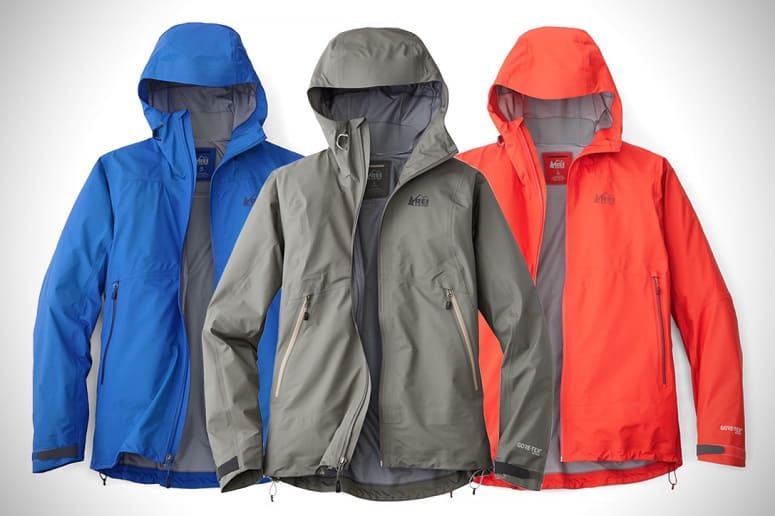
Gore-Tex has almost become synonymous with waterproof outerwear technologies over the last decade or so and for a while the brand enjoyed something of a monopoly over the market. Its current market leaders include Gore-Tex Pro and Gore-Tex Active.
Gore-Tex Pro: Pretty much the gold standard of waterproofing (30,000 mm HH) and, as such, the ideal choice for high-mountain ascents and particularly wet conditions. “Pro” jackets also boast a very healthy breathability rating of 20k.
Gore-Tex Active: “Active” models are generally lighter and far more breathable than Gore’s “Pro” range. Offering HH ratings in the region of 15 to 20k and breathability ratings in the region of 25-30k, they are the ideal choice for trail runners, ski-mountaineers, and those doing their hiking in warmer climates.
eVent
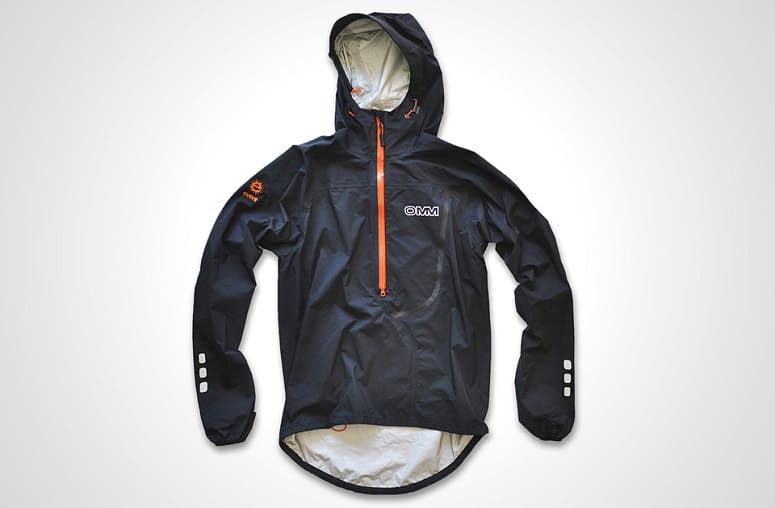
eVent membranes are very similar to those of Gore-Tex, with the exception that they leave out the polyurethane coating in order to maximize breathability.
While not as capable of withstanding sustained precipitation as either of Gore’s main membrane types, eVent jackets are solid performers in humid conditions and, for many users, shift sweat far quicker than comparable membranes from other brands.
PreCip
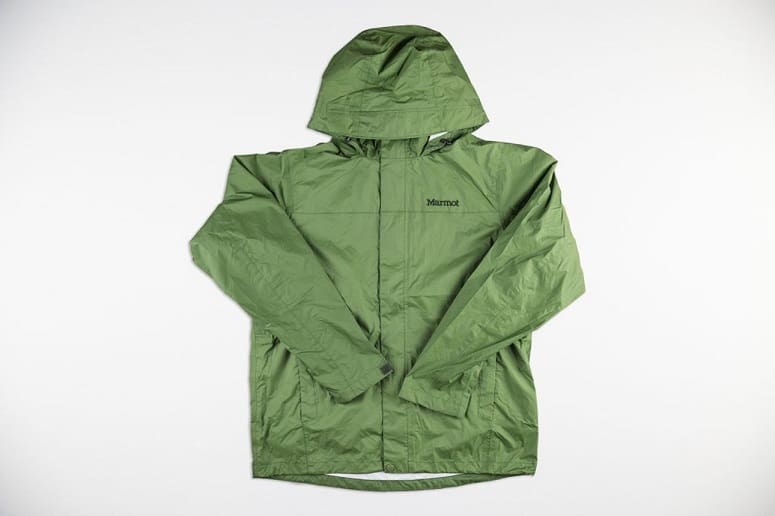
With a hydrostatic head rating and breathability rating of 10k, Marmot’s 3-layer PreCip membranes offer a kind of mid-range equivalent of the top-end models produced by the likes of Gore and Outdoor Research’s AscentShell. A decent choice for those on a budget but not the best for more extreme activities.
HyVent
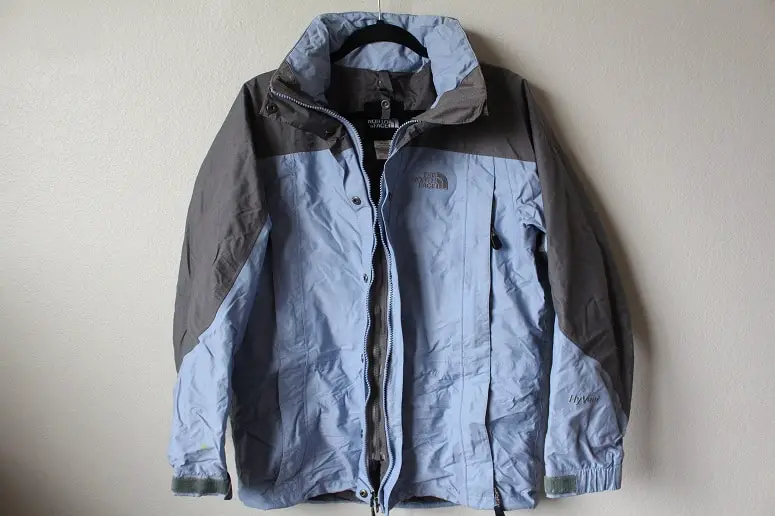
The North Face’s HyVent jackets use a 2.5 layer construction with HH and breathability ratings that vary from model to model but generally perform well—if not exceptionally well—across the board in terms of waterproofing, breathability, and durability.
H2No
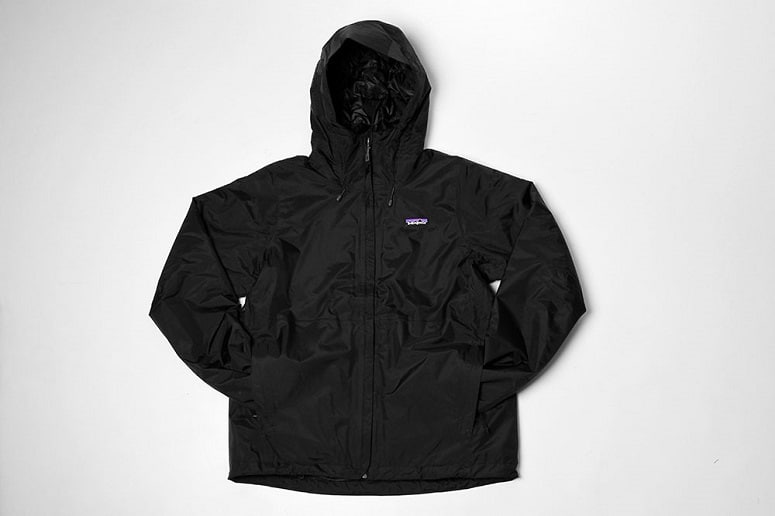
Patagonia’s H2No jackets live up to their name thanks to a 2 or 3-layer construction that includes a water-repellent shell and a highly breathable waterproof membrane with a HH rating of 20k. The best blend of waterproofing and breathability out there? If it isn’t, we’ve yet to see the jacket that is…
AscentShell
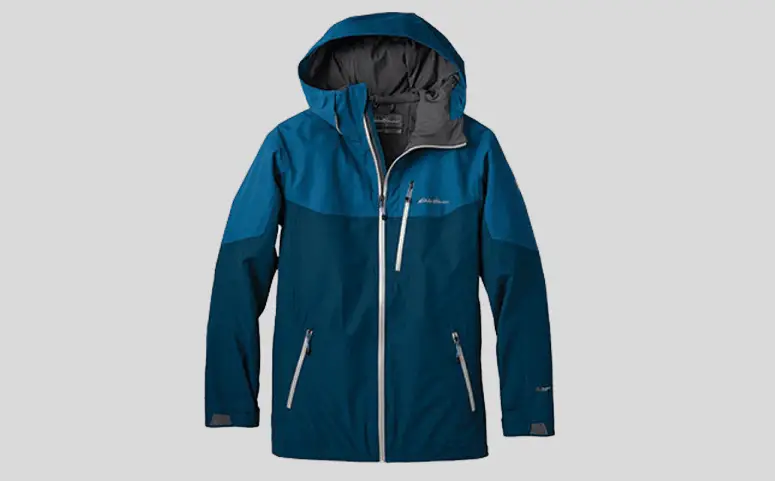
Outdoor Research’s proprietary membrane provides both excellent waterproofing and great breathability. While this alone is enough to make it a standout amongst most of its competitors, where it really excels is in the stretchiness of its fabric, which allows for a lot more mobility than many other high-end membranes. The catch? It will cost you a small fortune…
What makes a good waterproof jacket?
As mentioned above, the best waterproof jacket for your needs will largely depend on your activity type and how and where you plan on using it.
That said, there are a number of universally desirable attributes that can make any waterproof jacket a standout amongst its peers. The most notable of these are waterproofing capacity, breathability, and “dialed in” additional features.
Waterproofing capacity: hydrostatic head explained
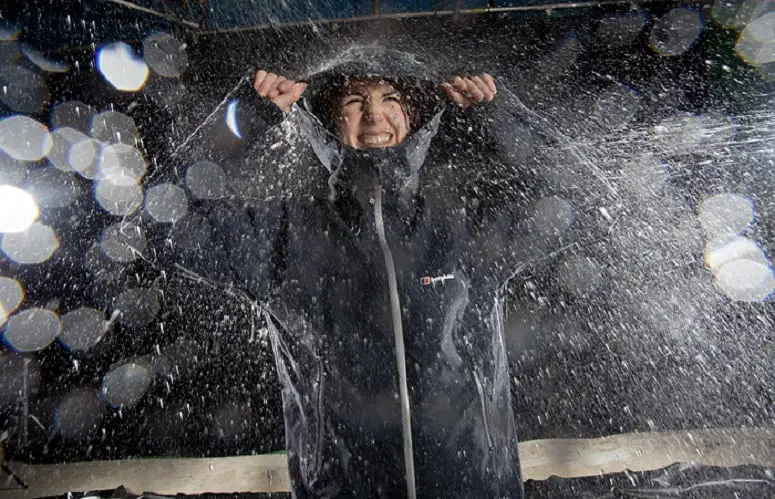
The waterproofing capacity of any outdoor jacket is quantified by what is know as the Hydrostatic Head (HH) rating.
This rating reveals how much water pressure the fabric of any jacket is able to withstand in laboratory tests before allowing water to seep through and is given as a number that is usually between 5,000 and 30,000 (i.e. 15,000 mm).
In short, the higher the figure in the hydrostatic head rating, the more waterproof the jacket will be.
The chart below offers an at-a-glance guide to various hydrostatic head ratings and how these equate to waterproofing performance for the user.
- 5,000≤ mm — The minimum hydrostatic head rating required for a jacket to be marketed as “waterproof” is 1,500 mm, but anything under the 5k mark is, in reality, unlikely to keep you dry in all but the lightest of passing rain showers.
- 10,000 mm — 10k-rated jackets tend to go one of two ways: either they are budget, urban-wear models mean for day-to-day use around the city or are those intended for intensely aerobic activities that use this lower waterproof rating in order to prioritize breathability. While enough to keep you dry in moderate rainshowers, jackets with this rating are unlikely to hold up in a downpour or under sustained exposure to precipitation and strong winds.
- 20,000 mm — Jackets with this rating are usually the ideal choice for those looking for a happy medium between breathability and waterproofing, but some brands (eVent, for example) maintain that a 20k mm hydrostatic head rating is the max requirement for hikers and, as such, don’t carry anything higher in their range. In short, this rating is a safe bet for anyone not headed into extreme environments where the combination of strong winds and steady precipitation will make a 30k-rated jacket a better option.
- 30,000 mm — While considered “overkill” by many manufacturers, this rating is favored by others such as Gore-Tex and is a better choice for those who envision spending a lot of time on high alpine routes, in particularly harsh conditions, or simply wish to have the maximum protection available, even if—as is the case in some, but not all, models with this rating—it means sacrificing a little in the way of breathability.
Breathability explained
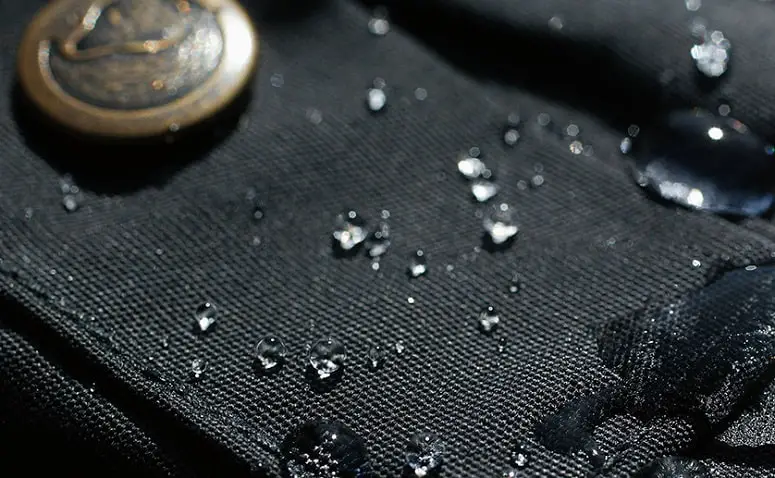
Along with waterproofing, breathability is the most important factor to consider when choosing a waterproof jacket.
While this might strike some as strange, if you have a jacket that performs very well in terms of waterproofing but not breathability, the chances are you’ll end up just as wet as you would if exposed to a downpour owing to the build-up of sweat on the jacket’s interior.
In short, breathability allows sweat to escape, or “wick”, through the fabric of your jacket by a process known as MVT — Moisture Vapor Transfer—which is quantified in a measurement known as the Moisture Vapor Transmission Rate.
Moisture Vapor Transmission Rate (MVRT)
Moisture Vapor Transmission Rates are given in product descriptions as g/m2/day or g/m2/24h (for example, “15,000g/m2/day”), which refers to grams per square meter (m2) per day (24h).
This metric is calculated by measuring how much water seeps through a single square meter of fabric stretched over a water container as vapor over the course of a full day. As with hydrostatic head ratings, the higher the figure, the better the breathability.
The figures below summarize how you can expect various MVRT ratings to perform out on the trails.
- 5,000 g/m2/day — Jackets with this breathability rating are most commonly intended for day-to-day use in urban environments and are not ideally suited to pursuits of a more aerobic nature. While these could be okay for activities that are slower-moving such as ice-climbing and outdoor photography, we wouldn’t recommend them to hikers or anyone liable to be working up a sweat
- 10,000—15,000 g/m2/day — This rating is found on most hiking and backpacking jackets and offers enough breathability for all but those participating in extremely aerobic activities like trail running or ski mountaineering or who are doing their hiking in particularly warm climates
- 20,000+ g/m2/day — This rating is the best bet for those whose outdoor pursuits are more athletic and aerobic in nature or who anticipate hiking in exceptionally sweaty environments
Important features
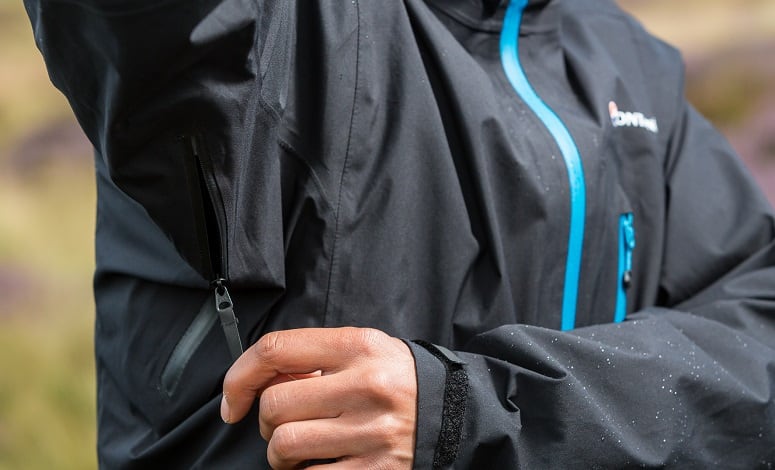
A handful of features can vastly improve the performance and convenience of your waterproof jacket. The most important of these are as follows:
- Pit zippers — Underarm zippers can provide the ideal “heat dump” when things get a little sticky without exposing your interior layers to precipitation
- Adjustable cuffs — Although most cheaper jacket models feature elasticated cuffs that close tightly around the wrists, adjustable Velcro wrist closures will give you the option of letting in a little air when necessary
- Helmet-compatible hood — An oversized, helmet-compatible hood, as the name suggests, allows you to wear a helmet underneath the hood without the material at the waist of the jacket riding up and exposing your midriff to the elements or drafts
- Adjustable hood — This allows you to cinch down the hood in blustery weather to provide maximum insulation and weather protection and prevents the hood from blowing back off your head or into your eyes
- Peaked hood — This feature helps to keep the rain off of your face and out of your eyes, thereby maximizing visibility and greatly reducing, we assure you, frustration
- Backpack-friendly pockets — For reasons known only to the manufacturers, many hiking jackets feature pockets that are positioned in perhaps the most inconvenient place possible—that is, directly behind the hip belt on your backpack. If you’re the type of hiker who likes to stow the odd item in your pockets or just put your hands in them from time to time, look for a jacket with pockets that are placed higher on the torso so they will be accessible when wearing your backpack’s hip belt
- Mesh pockets – As with pit zips and adjustable cuffs, these can provide a handy “heat dump” when things start getting a little sweaty
- Taped seams — This feature adds waterproofing to the areas (that is, the seams) most vulnerable to permeation by water and is usually only found on pricier models of jacket
Conclusion
Finding the best waterproof jackets for your needs will depend on a number of factors and, ultimately, how and where you plan to use it.
Whatever type of outdoor activity you are into, however, getting your hands on your future go-to jacket for wet-weather adventures usually comes down to finding the best balance of waterproofing, breathability, and those “bonus” features that can make the jacket more practical and better suited to your sport.
How did you like our guide to choosing a waterproof jacket? Please feel free to like, comment, and share with your friends and let us know if we missed anything out!


